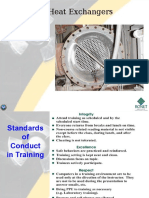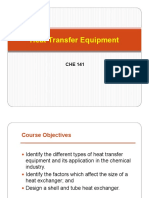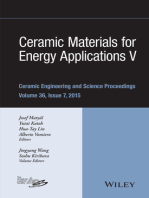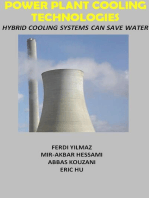0 ratings0% found this document useful (0 votes)
46 viewsItaly 2014ugm Analysis of Embaffle Heat Exchanger
Italy 2014ugm Analysis of Embaffle Heat Exchanger
Uploaded by
phisitlaiParametric CFD analysis of an EMbaffle Heat Exchanger, comparison between some experimental tests and the parametric CFD model was performed in order to validate it.
Copyright:
© All Rights Reserved
Available Formats
Download as PDF, TXT or read online from Scribd
Italy 2014ugm Analysis of Embaffle Heat Exchanger
Italy 2014ugm Analysis of Embaffle Heat Exchanger
Uploaded by
phisitlai0 ratings0% found this document useful (0 votes)
46 views40 pagesParametric CFD analysis of an EMbaffle Heat Exchanger, comparison between some experimental tests and the parametric CFD model was performed in order to validate it.
Copyright
© © All Rights Reserved
Available Formats
PDF, TXT or read online from Scribd
Share this document
Did you find this document useful?
Is this content inappropriate?
Parametric CFD analysis of an EMbaffle Heat Exchanger, comparison between some experimental tests and the parametric CFD model was performed in order to validate it.
Copyright:
© All Rights Reserved
Available Formats
Download as PDF, TXT or read online from Scribd
Download as pdf or txt
0 ratings0% found this document useful (0 votes)
46 views40 pagesItaly 2014ugm Analysis of Embaffle Heat Exchanger
Italy 2014ugm Analysis of Embaffle Heat Exchanger
Uploaded by
phisitlaiParametric CFD analysis of an EMbaffle Heat Exchanger, comparison between some experimental tests and the parametric CFD model was performed in order to validate it.
Copyright:
© All Rights Reserved
Available Formats
Download as PDF, TXT or read online from Scribd
Download as pdf or txt
You are on page 1of 40
Parametric CFD analysis of an
EMbaffle Heat Exchanger
EMbaffle B.V.
The Netherlands
Brembana&Rolle Group
Brembana&Rolle Group
Reactors
Pressure Vessels & Columns
Conventional Heat Exchangers
Advanced Heat Exchangers
Waste Heat Recovery Units
Fired Heaters
ORC Systems
Brembana&Rolle Group
Reactors
Pressure Vessels & Columns
Conventional Heat Exchangers
Advanced Heat Exchangers
Waste Heat Recovery Units
Fired Heaters
ORC Systems
Brembana&Rolle Group
Reactors
Pressure Vessels & Columns
Conventional Heat Exchangers
Advanced Heat Exchangers
Waste Heat Recovery Units
Fired Heaters
ORC Systems
Brembana&Rolle Group
Reactors
Pressure Vessels & Columns
Conventional Heat Exchangers
Advanced Heat Exchangers
Waste Heat Recovery Units
Fired Heaters
ORC Systems
Brembana&Rolle Group
Reactors
Pressure Vessels & Columns
Conventional Heat Exchangers
Advanced Heat Exchangers
Waste Heat Recovery Units
Fired Heaters
ORC Systems
Brembana&Rolle Group
Reactors
Pressure Vessels & Columns
Conventional Heat Exchangers
Advanced Heat Exchangers
Waste Heat Recovery Units
Fired Heaters
ORC Systems
Brembana&Rolle Group
Reactors
Pressure Vessels & Columns
Conventional Heat Exchangers
Advanced Heat Exchangers
Waste Heat Recovery Units
Fired Heaters
ORC Systems
Brembana&Rolle Group
Step 1:
Original concepts and patents
Step 2:
Full-scale manufacturing and field
tests in Shell operating plants
Step 3:
Initial commercial licensing agreements
2002/04
Shell Global Solutions
2004/06
Netherlands and USA
2004/06
Globally
2007
Step 4:
EMbaffle B.V. owned by Shell
Technology Ventures Fund I
2012
Step 5:
EMbaffle B.V. owned by B&R
EMbaffle Technology
Grid Production Process:
A sheet of metal is passed
through a cutter
It is simultaneously cut and
expanded
The resulting expanded sheet is
welded to a support ring
EMbaffle Characteristics:
EMbaffle Technology
EMbaffle Characteristics:
Full tube support
Segmental baffle EMbaffle
EMbaffle Technology
EMbaffle Characteristics:
Full tube support
Open structure allowing pure longitudinal flow
EMbaffle Segmental baffle
EMbaffle Technology
EMbaffle Characteristics:
Full tube support
Open structure allowing pure longitudinal flow
No tubes vibration
EMbaffle Technology
EMbaffle Characteristics:
Full tube support
Open structure allowing pure longitudinal flow
Enhanced turbulence hence heat transfer coefficient
EMbaffle Technology
EMbaffle Characteristics:
Full tube support
Open structure allowing pure longitudinal flow
Enhanced turbulence hence heat transfer coefficient
More compact design
EMbaffle Technology
EMbaffle Characteristics:
Geometry
(EMbaffle)
Fluid Dynamics
(Turbulence)
Thermodynamics
(Heat Transfer)
Low Shell side
Fouling
No Tube
Vibration
Low
Pressure Drop
Energy & CO
2
Savings
EMbaffle Technology
EMbaffle Applications:
Gas-to-gas (Gas Fields, LNG, etc)
Gas-to-liquid (Gas Coolers)
On-shore and off-shore processing
Refining and petrochemical
Concentrated Solar Power (CSP)
Geothermal
EMbaffle Technology
CFD Parametric Model
LWD Long Way of the grid Diamond
SWD Short Way of the grid Diamond
BL Bond Length
SW Strand Width
MT Material Thickness
Psi Deviation angle of the Strand Width
TOD Tube Outer Diameter
TT Tube Thickness
BS Baffle Spacing
n Number of consecutive grids
CFD Parametric Model
CFD Parametric Model
a) TubeFluid domain
b) Tube domain
c) ShellFluid domain
CFD Parametric Model
CFD Parametric Model
ShellFluid:
Symmetry
TubeFluid:
translational periodicity
CFD Parametric Model
Starting from 2002, several experimental tests were performed by
EMbaffle in collaboration with:
Tests results were used to develop the correlations used to design
an EMbaffle heat exchanger by means of the software:
Analysis Cases
Flow direction
Shell-side (n-pentane) Tube-side (water)
T
in
(C) v
in
(m/s) P
in
(kPa) T
in
(C) v
in
(m/s) P
in
(kPa)
Counter-
current
48 0.223
1636.2 95.64 0.431 665.96
Analysis Cases
Analysis Cases
1) Influence of the turbulence model on the performance
Analysis Cases
1) Influence of the turbulence model on the performance
2) Influence of the baffle spacing on the performance
Analysis Cases
Influence of the turbulence model on the performance:
ShellFluid domain: Shear Stress Transport
Analysis A:
TubeFluid domain: Shear Stress Transport
ShellFluid domain: Detached Eddy Simulation
Analysis B:
TubeFluid domain: Shear Stress Transport
Analysis Case 1
Results Case 1
Results Case 1
Results Case 1
Experimental
data
CFD Case 1 CFD Case 2 Units
SHELLSIDE
(COLD FLUID)
Fluid n-Pentane -
Turbulence Model - RANS-SST URANS-DES -
Mass flow rate 0.027709 Kg/s
Inlet velocity 0.222937 m/s
Inlet temperature 48 C
Outlet temperature 83.47 76.7 76.8 C
Boundary Conditions
Heat Transfer Coefficient - 11000 W/m2 K
Outside Temperature - 85 C
COMPARISON DATA
Exchanged duty 2546 2069.9 2110.6 W
Duty mismatch -
-18.7 -17.1
%
Influence of the baffle spacing on the performance:
Analysis A: baffle spacing = 50 mm
Analysis B: baffle spacing = 100 mm
Analysis C: baffle spacing = 200 mm
Analysis Case 2
Results Case 2
0.0002
0.0003
0.0004
0.0005
0.0006
0.0007
0.0008
0.0009
0.001
0.0011
0.0012
200 250 300 350 400
T
.
K
.
E
[
m
^
2
/
s
^
2
]
X direction [mm]
BS = 50 mm
BS = 100 mm
BS = 200 mm
FLOW DIRECTION
Results Case 2
Baffle spacing [mm]
Turbulence decay distance
from baffle [%]
50 86
100 37
200 18.5
A comparison between some experimental tests and the
parametric CFD model was performed in order to validate it.
Two different turbulence models were applied to the shell-
side fluid domain to find out which one was better matching
the experimental data.
Results show that the CFD model is too conservative in
comparison to the real performance of the EMbaffle HEX,
even if the DES model seems to better match the real
performance.
Conclusion
Performing extensive tests with several fluids (gas, molten
salts, etc..) at different Reynolds ranges
Investigating the effect of different grid shapes on the thermal
and hydraulic performance
Investigating the optimum baffle spacing in terms of
minimum pressure drop and maximum heat transfer
coefficient for each application
Simulating two phases flow
Future developments
Thank you for your attention
For further information:
www.EMbaffle.com
Info@EMbaffle.com
You might also like
- DENR Administrative Order 97-32Document13 pagesDENR Administrative Order 97-32Boo DalupsNo ratings yet
- Air Cooled Heat Exchanger Handbook: Fundamentals, Calculations, Design and Q&AFrom EverandAir Cooled Heat Exchanger Handbook: Fundamentals, Calculations, Design and Q&ANo ratings yet
- Assignment 2Document25 pagesAssignment 2Ahmet Samet ÖzdilekNo ratings yet
- Heat Exchangers (1) REPAIRDocument133 pagesHeat Exchangers (1) REPAIRJOÃO CARLOS SILVA100% (3)
- Elleptic CurveDocument17 pagesElleptic CurveTanveer AkhtarNo ratings yet
- Fidelity 401kDocument7 pagesFidelity 401kTom BiusoNo ratings yet
- Hts Song Presentation2011Document46 pagesHts Song Presentation2011Anonymous 8te2h1No ratings yet
- Best Practices in Energy Efficiency in Cement Sector CFD Final PDFDocument53 pagesBest Practices in Energy Efficiency in Cement Sector CFD Final PDFPradeepNo ratings yet
- Heat Sink 101Document12 pagesHeat Sink 101Eduardo Salgado EnríquezNo ratings yet
- Lecture 6 - Heat Transfer EquipmentDocument72 pagesLecture 6 - Heat Transfer EquipmentLouie GresulaNo ratings yet
- Process Presentation Shell and Tube Heat Exchanger GalfarDocument84 pagesProcess Presentation Shell and Tube Heat Exchanger GalfarKishore Sakhile100% (1)
- CFD Analysis of Shell and Tube Heat Exchanger A ReviewDocument5 pagesCFD Analysis of Shell and Tube Heat Exchanger A Reviewteguh hady aNo ratings yet
- Practical Aspects of Condenser and Reboiler DesignDocument11 pagesPractical Aspects of Condenser and Reboiler DesignForcus on100% (1)
- 6 Polley Compabloc FDocument5 pages6 Polley Compabloc FarianaseriNo ratings yet
- CFD Study Heat PipeDocument8 pagesCFD Study Heat PipeSalman Chowdhury ShawonNo ratings yet
- Particle-To-fluid Direct-Contact Counter-Flow Heat Exchanger Simple-Models Validation and Integration With A Particle-Based Central Tower SystemDocument16 pagesParticle-To-fluid Direct-Contact Counter-Flow Heat Exchanger Simple-Models Validation and Integration With A Particle-Based Central Tower SystemalaqelshakerNo ratings yet
- Air Preheater DesignDocument7 pagesAir Preheater Designnarendradounde143No ratings yet
- Enhancing The Heat-Transfer Co-Efficient by Using Taguchi Orthogonal ArrayDocument4 pagesEnhancing The Heat-Transfer Co-Efficient by Using Taguchi Orthogonal ArrayinventionjournalsNo ratings yet
- Numerical Investigation of 3D Flow and Thermal Effects in A Disc-Type TransformerDocument11 pagesNumerical Investigation of 3D Flow and Thermal Effects in A Disc-Type TransformerdgtzagaNo ratings yet
- Heat TransferDocument77 pagesHeat TransferSabariMechy50% (2)
- Double Pipe by Sannan & HarisDocument72 pagesDouble Pipe by Sannan & HarisQuân Nguyễn ĐìnhNo ratings yet
- Prepared By: Mr. Harsh PanchalDocument46 pagesPrepared By: Mr. Harsh PanchalKáûshàl PãtëlNo ratings yet
- Numerical and Experimental Studies On Heat Transfer in Circulating Fluidized Bed BoilersDocument37 pagesNumerical and Experimental Studies On Heat Transfer in Circulating Fluidized Bed BoilersmlsimhanNo ratings yet
- Computational Fluid Dynamics Investigation of Air Cooled Heat ExchangersDocument6 pagesComputational Fluid Dynamics Investigation of Air Cooled Heat ExchangersCarlos VegaNo ratings yet
- JT LTS Vs VortexDocument4 pagesJT LTS Vs VortexIlya Popik100% (1)
- A Numerical Model For Thermal-Hydraulic Design of A Shell and Single Pass Low Finned Tube Bundle Heat ExchangerDocument27 pagesA Numerical Model For Thermal-Hydraulic Design of A Shell and Single Pass Low Finned Tube Bundle Heat ExchangerSilvio PeluffoNo ratings yet
- Boiler Retrofit PDFDocument44 pagesBoiler Retrofit PDFTim KuNo ratings yet
- NuFoam SAFIR2010Document20 pagesNuFoam SAFIR2010Monssif NajimNo ratings yet
- Models - Heat.shell and Tube Heat ExchangerDocument26 pagesModels - Heat.shell and Tube Heat ExchangerLuis Esteban Vela DonosoNo ratings yet
- 3fd1 PDFDocument8 pages3fd1 PDFPrajyot Kumar MishraNo ratings yet
- Funke Shell Tube He eDocument24 pagesFunke Shell Tube He eSubrata DasNo ratings yet
- Application of CFD QuenchDocument42 pagesApplication of CFD Quenchluigi_mazzuccoNo ratings yet
- Student Name ID: Aysha Housani 200503484 Maha Al Shehhi 200509462 Hessa Al Shehhi 200509582 Mona Thabet 200521150Document78 pagesStudent Name ID: Aysha Housani 200503484 Maha Al Shehhi 200509462 Hessa Al Shehhi 200509582 Mona Thabet 200521150minumcincauNo ratings yet
- An Approach For TopologyDocument32 pagesAn Approach For Topologyemma.fumaratiNo ratings yet
- Heat Exchanger Design - Part 1Document26 pagesHeat Exchanger Design - Part 1Siddhant SoymonNo ratings yet
- Heat Pipe SelectionDocument6 pagesHeat Pipe SelectionSridhar RaoNo ratings yet
- FE Simulation of Engine Head Block For Structural DurabilityDocument19 pagesFE Simulation of Engine Head Block For Structural DurabilityPankaj Gambhire100% (2)
- Heat Exchanger Design GuideDocument20 pagesHeat Exchanger Design GuideJack ClarkeNo ratings yet
- Heat Pipe PHD ThesisDocument6 pagesHeat Pipe PHD Thesismichelledavisvirginiabeach100% (1)
- Basic Refinery Equipment - Heat Exchanger (E003/1)Document27 pagesBasic Refinery Equipment - Heat Exchanger (E003/1)ebsmsart100% (1)
- Heat ExchangersDocument107 pagesHeat ExchangersMAMADO2015No ratings yet
- eBroc-Shell and Tube Heat Exchangers Model Series and Customer Oriented Solutions, FunkeDocument18 pageseBroc-Shell and Tube Heat Exchangers Model Series and Customer Oriented Solutions, FunkeMoly69xNo ratings yet
- Heat Pipe ThesisDocument7 pagesHeat Pipe Thesisbrookelordmanchester100% (2)
- Conjugate Heat Transfer PDFDocument10 pagesConjugate Heat Transfer PDFbenabedmNo ratings yet
- Kern Method Heat ExchangerDocument30 pagesKern Method Heat ExchangerCS100% (3)
- Process Steam Systems: A Practical Guide for Operators, Maintainers, and DesignersFrom EverandProcess Steam Systems: A Practical Guide for Operators, Maintainers, and DesignersNo ratings yet
- Southern Marine Engineering Desk Reference: Second Edition Volume IFrom EverandSouthern Marine Engineering Desk Reference: Second Edition Volume INo ratings yet
- Heating Systems Troubleshooting & Repair: Maintenance Tips and Forensic ObservationsFrom EverandHeating Systems Troubleshooting & Repair: Maintenance Tips and Forensic ObservationsNo ratings yet
- Ceramic Materials for Energy Applications V: A Collection of Papers Presented at the 39th International Conference on Advanced Ceramics and CompositesFrom EverandCeramic Materials for Energy Applications V: A Collection of Papers Presented at the 39th International Conference on Advanced Ceramics and CompositesJosef MatyášNo ratings yet
- The Handbook of Heating, Ventilation and Air Conditioning (HVAC) for Design and ImplementationFrom EverandThe Handbook of Heating, Ventilation and Air Conditioning (HVAC) for Design and ImplementationRating: 1 out of 5 stars1/5 (1)
- Thermal Modelling of Power Transformers Using Computational Fluid DynamicsFrom EverandThermal Modelling of Power Transformers Using Computational Fluid DynamicsNo ratings yet
- Advances in Solid Oxide Fuel Cells XFrom EverandAdvances in Solid Oxide Fuel Cells XMihails KusnezoffNo ratings yet
- 10.4271@2012 01 0178Document9 pages10.4271@2012 01 0178H HNo ratings yet
- Research Papers On Real Estate ValuationDocument4 pagesResearch Papers On Real Estate Valuationgxkswirif100% (1)
- Altera - ENDocument8 pagesAltera - ENDoanh NguyenNo ratings yet
- MER331 - Lab 1: An Introduction To Uncertainty AnalysisDocument24 pagesMER331 - Lab 1: An Introduction To Uncertainty Analysischemist_tmaNo ratings yet
- Digital Circuits: EE/CE 3320 / Spring 2020 / Lecture 12Document82 pagesDigital Circuits: EE/CE 3320 / Spring 2020 / Lecture 12Muhammad MontahaNo ratings yet
- Mod1 PDFDocument277 pagesMod1 PDFKavya SharmaNo ratings yet
- ACLS Secondary Survey For A Patient in Respiratory ArrestDocument3 pagesACLS Secondary Survey For A Patient in Respiratory ArrestLaili Cinthia0% (1)
- FELPRO - Tablas-de-Torque - 022Document1 pageFELPRO - Tablas-de-Torque - 022Clodoaldo BiassioNo ratings yet
- LAC SESSION TEMPLATE DISTRICT MUNICIPAL SCHOOL LEVEL Revised 8 17 2017Document3 pagesLAC SESSION TEMPLATE DISTRICT MUNICIPAL SCHOOL LEVEL Revised 8 17 2017Jakie UbinaNo ratings yet
- The Occupational & Safety Health Management & Workers Productivity: The Relationship & EffectDocument25 pagesThe Occupational & Safety Health Management & Workers Productivity: The Relationship & EffectAhmedAymanNo ratings yet
- Did You Mean:: SadasdasDocument2 pagesDid You Mean:: Sadasdaskraen zilNo ratings yet
- Design and Construction ReportDocument60 pagesDesign and Construction ReporthutuguoNo ratings yet
- Reliability Ab PDFDocument4 pagesReliability Ab PDFLuis Alberto SanchezNo ratings yet
- Assignment # (02) : Abasyn University Peshawar Department of Computer ScienceDocument4 pagesAssignment # (02) : Abasyn University Peshawar Department of Computer ScienceAndroid 360No ratings yet
- Chopin (Vodka) : See AlsoDocument2 pagesChopin (Vodka) : See AlsoNirmal BhowmickNo ratings yet
- Materi CRMP ERM V1.text - MarkedDocument96 pagesMateri CRMP ERM V1.text - MarkedBastian SiahaanNo ratings yet
- PRF - SupplierDocument18 pagesPRF - Supplierdeanwolves16No ratings yet
- Manual CNC StudioDocument31 pagesManual CNC StudioFrancisco MoncayoNo ratings yet
- CI - Capacity Building For Maintenance of Meteorological Instruments and Early Warning SystemDocument20 pagesCI - Capacity Building For Maintenance of Meteorological Instruments and Early Warning SystemHairatun NisaNo ratings yet
- Ros Lab 3Document27 pagesRos Lab 3Souad BouzianeNo ratings yet
- GMAT-800 Performance Chart 15novDocument13 pagesGMAT-800 Performance Chart 15novArun PrakashNo ratings yet
- Evidencia - 7 - Workshop - Talking - About - Logistics - V2 - FDocument6 pagesEvidencia - 7 - Workshop - Talking - About - Logistics - V2 - FGuillermo Andres Rodriguez CruzNo ratings yet
- 70.3590 - GB - JUMO IMAGO 500Document12 pages70.3590 - GB - JUMO IMAGO 500chris110No ratings yet
- Chapter 2Document3 pagesChapter 2EmeLene PatunganNo ratings yet
- Key AttributesDocument57 pagesKey AttributesangeloalvesNo ratings yet
- Chapter - 5 - c.MCQs On Workmen Compensation Act 1923Document4 pagesChapter - 5 - c.MCQs On Workmen Compensation Act 1923S M Mandar100% (1)
- Automatic Bottle Filling and Capping Machine Using SCADA With The Internet of ThingsDocument6 pagesAutomatic Bottle Filling and Capping Machine Using SCADA With The Internet of Thingsa.louiziniNo ratings yet

























































































